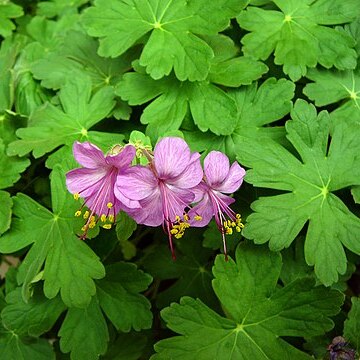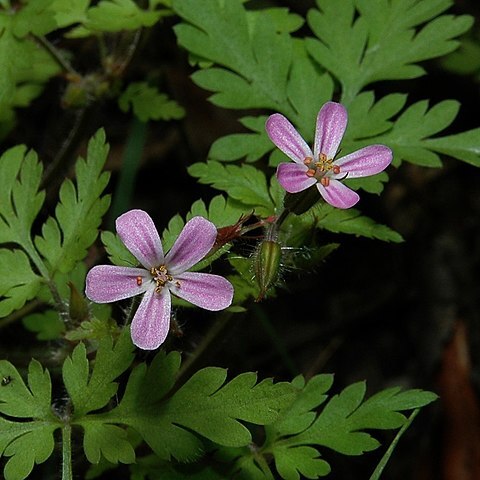Annual or perennial herbs, subshrubs or shrubs, often with a taproot; glabrous or with indumentum of simple, sometimes glandular, hairs. Stems sometimes succulent. Leaves opposite or alternate, petiolate, simple or compound, often lobed or toothed; venation often palmate; stipules present, sometimes interpetiolar. Inflorescence terminal, in cymose umbels, or paired or solitary and apparently axillary; bracts present or absent. Flowers actinomorphic or zygomorphic, bisexual, usually 5-merous. Sepals 5, rarely 4, free or basally fused and prolonged into a basal nectariferous spur, usually mucronate, persistent, often enlarged in fruit. Petals 5, rarely fewer or absent, free, imbricate, usually alternating with nectar-secreting glands. Stamens 5 with a whorl of 5 staminodes, 10 in two whorls, sometimes a few sterile, or 15 (not in Australia); filaments free or basally united; anthers 2-locular, dehiscing by longitudinal slits, introrse. Gynoecium of 5, rarely 3 or 4 fused carpels. Ovary superior, usually 5-loculular and 5-lobed; ovules 2 per loculus; style 5-lobed. Fruit a schizocarp, splitting into 5 mericarps, each 1-seeded and awned, elastically separating from the central column of the style (rostrum) or remaining attached at the summit, or splitting into 5 unconnected mericarps (not in Australia).
Herbs, annual or perennial [rarely shrublets or shrubs]. Stipules present. Leaves alternate or opposite, palmately or pinnately divided, petiolate. Flowers in cymes, pseudoumbels, rarely flowers solitary, usually bisexual, actinomorphic, or ± zygomorphic. Sepals 5, usually distinct, imbricate. Petals usually 5, distinct. Fertile stamens 5 or 10, usually in 2 whorls, sometimes a whorl reduced to staminodes; filaments basally connate or distinct; anthers 2-locular, longitudinally dehiscent. Ovary superior; carpels 5, connate; ovules 1 or 2 per locule, pendulous, anatropous. Fruit a schizocarp with 5 1-seeded awned mericarps which separate elastically from a central beak. Seeds usually with little or no endosperm; embryo folded.
Ovary superior, syncarpous, 3–5 (rarely 2 or 8)-locular, usually lobed, usually rostrate (always in our area); style present or absent; stigmas ligulate, clavate or filiform, rarely capitate; loculi 1–2 ovulate; ovules pendulous, anatropous, superposed, placentation axile
Stamens usually obdiplostemonous, twice as many as the sepals, more rarely 3 times as many (some sometimes sterile); filaments usually 4: connate at the base, sometimes in 5 bundles of 3 each; anthers 2-thecous, dehiscing longitudinally, introrse
Fruit a schizocarp or sometimes a 3–5 (rarely 8)-lobed capsule; lobes or mericarps usually 1-seeded and dehiscing septicidally; mericarps (cocci) rostrate, breaking away from a persistent central column
Leaves alternate or opposite, if opposite often unequal, usually stipulate and petiolate, serrate, crenate or dentate, lobed or dissected or compound, rarely entire
Stamens 2–3 times the number of the sepals, sometimes a few without anthers; filaments mostly more or less connate at the base; anthers 2-celled, opening lengthwise
Annual herbs or undershrubs, rarely arborescent; leaves alternate or opposite, mostly lobate, dissected or compound; stipules often paired
Sepals persistent, 4–5, free or connate to the middle, imbricate or rarely valvate, the dorsal one sometimes spurred
Flowers often handsome, hermaphrodite, actinomorphic or slightly zygomorphic, axillary, solitary to subumbellate
Flowers bisexual (or very rarely dioecious), actinomorphic or zygomorphic, hypogynous, 5 (rarely 4 or 8)-merous
Sepals persistent, free or connate at the base, usually imbricate, the posterior one sometimes spurred
Petals 5, rarely 4, very rarely absent, hypogynous or subperigynous, imbricate, rarely contorted
Seeds smooth or minutely reticulate; embryo curved, rarely straight; endosperm scanty or absent
Seeds pendulous, with thin or no (rarely copious) endosperm and mostly curved or folded embryo
Fruit lobed; lobes 1-seeded, rarely more-seeded, often beaked, opening from the base upwards
Ovary 3–5-lobed; ovules 1–2 in each cell, superposed, pendulous, rarely more than 2
Inflorescence usually axillary, sometimes pseudumbellate (rarely 1-flowered)
Petals free, usually imbricate, occasionally 4, 2 or 0 by reduction
Herbs, shrubs or suffrutices, very rarely arborescent
Disk (or extrastaminal) glands often present


